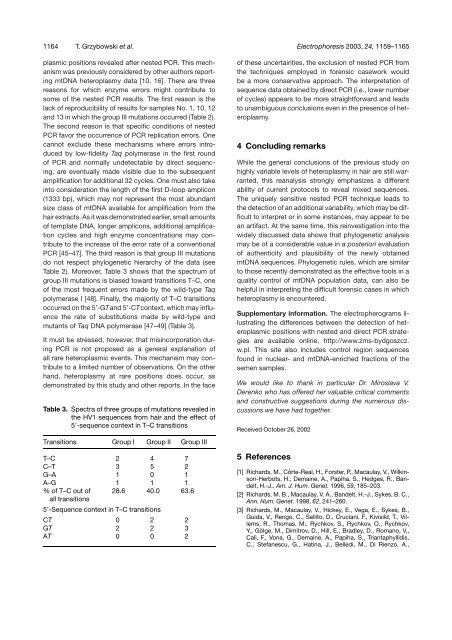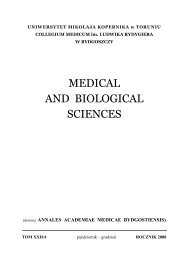High levels of mitochondrial DNA heteroplasmy in single hair roots ...
High levels of mitochondrial DNA heteroplasmy in single hair roots ...
High levels of mitochondrial DNA heteroplasmy in single hair roots ...
You also want an ePaper? Increase the reach of your titles
YUMPU automatically turns print PDFs into web optimized ePapers that Google loves.
1164 T. Grzybowski et al. Electrophoresis 2003, 24, 1159–1165<br />
plasmic positions revealed after nested PCR. This mechanism<br />
was previously considered by other authors report<strong>in</strong>g<br />
mt<strong>DNA</strong> <strong>heteroplasmy</strong> data [10, 16]. There are three<br />
reasons for which enzyme errors might contribute to<br />
some <strong>of</strong> the nested PCR results. The first reason is the<br />
lack <strong>of</strong> reproducibility <strong>of</strong> results for samples No. 1, 10, 12<br />
and 13 <strong>in</strong> which the group III mutations occurred (Table 2).<br />
The second reason is that specific conditions <strong>of</strong> nested<br />
PCR favor the occurrence <strong>of</strong> PCR replication errors. One<br />
cannot exclude these mechanisms where errors <strong>in</strong>troduced<br />
by low-fidelity Taq polymerase <strong>in</strong> the first round<br />
<strong>of</strong> PCR and normally undetectable by direct sequenc<strong>in</strong>g,<br />
are eventually made visible due to the subsequent<br />
amplification for additional 32 cycles. One must also take<br />
<strong>in</strong>to consideration the length <strong>of</strong> the first D-loop amplicon<br />
(1333 bp), which may not represent the most abundant<br />
size class <strong>of</strong> mt<strong>DNA</strong> available for amplification from the<br />
<strong>hair</strong> extracts. As it was demonstrated earlier, small amounts<br />
<strong>of</strong> template <strong>DNA</strong>, longer amplicons, additional amplification<br />
cycles and high enzyme concentrations may contribute<br />
to the <strong>in</strong>crease <strong>of</strong> the error rate <strong>of</strong> a conventional<br />
PCR [45–47]. The third reason is that group III mutations<br />
do not respect phylogenetic hierarchy <strong>of</strong> the data (see<br />
Table 2). Moreover, Table 3 shows that the spectrum <strong>of</strong><br />
group III mutations is biased toward transitions T–C, one<br />
<strong>of</strong> the most frequent errors made by the wild-type Taq<br />
polymerase I [48]. F<strong>in</strong>ally, the majority <strong>of</strong> T–C transitions<br />
occurred on the 5’-GTand 5’-CTcontext, which may <strong>in</strong>fluence<br />
the rate <strong>of</strong> substitutions made by wild-type and<br />
mutants <strong>of</strong> Taq <strong>DNA</strong> polymerase [47–49] (Table 3).<br />
It must be stressed, however, that mis<strong>in</strong>corporation dur<strong>in</strong>g<br />
PCR is not proposed as a general explanation <strong>of</strong><br />
all rare heteroplasmic events. This mechanism may contribute<br />
to a limited number <strong>of</strong> observations. On the other<br />
hand, <strong>heteroplasmy</strong> at rare positions does occur, as<br />
demonstrated by this study and other reports. In the face<br />
Table 3. Spectra <strong>of</strong> three groups <strong>of</strong> mutations revealed <strong>in</strong><br />
the HV1 sequences from <strong>hair</strong> and the effect <strong>of</strong><br />
5’-sequence context <strong>in</strong> T–C transitions<br />
Transitions Group I Group II Group III<br />
T–C 2 4 7<br />
C–T 3 5 2<br />
G–A 1 0 1<br />
A–G 1 1 1<br />
% <strong>of</strong> T–C out <strong>of</strong> 28.6 40.0 63.6<br />
all transitions<br />
5’-Sequence context <strong>in</strong> T–C transitions<br />
CT 0 2 2<br />
GT 2 2 3<br />
AT 0 0 2<br />
<strong>of</strong> these uncerta<strong>in</strong>ties, the exclusion <strong>of</strong> nested PCR from<br />
the techniques employed <strong>in</strong> forensic casework would<br />
be a more conservative approach. The <strong>in</strong>terpretation <strong>of</strong><br />
sequence data obta<strong>in</strong>ed by direct PCR (i.e., lower number<br />
<strong>of</strong> cycles) appears to be more straightforward and leads<br />
to unambiguous conclusions even <strong>in</strong> the presence <strong>of</strong> <strong>heteroplasmy</strong>.<br />
4 Conclud<strong>in</strong>g remarks<br />
While the general conclusions <strong>of</strong> the previous study on<br />
highly variable <strong>levels</strong> <strong>of</strong> <strong>heteroplasmy</strong> <strong>in</strong> <strong>hair</strong> are still warranted,<br />
this reanalysis strongly emphasizes a different<br />
ability <strong>of</strong> current protocols to reveal mixed sequences.<br />
The uniquely sensitive nested PCR technique leads to<br />
the detection <strong>of</strong> an additional variability, which may be difficult<br />
to <strong>in</strong>terpret or <strong>in</strong> some <strong>in</strong>stances, may appear to be<br />
an artifact. At the same time, this re<strong>in</strong>vestigation <strong>in</strong>to the<br />
widely discussed data shows that phylogenetic analysis<br />
may be <strong>of</strong> a considerable value <strong>in</strong> a posteriori evaluation<br />
<strong>of</strong> authenticity and plausibility <strong>of</strong> the newly obta<strong>in</strong>ed<br />
mt<strong>DNA</strong> sequences. Phylogenetic rules, which are similar<br />
to those recently demonstrated as the effective tools <strong>in</strong> a<br />
quality control <strong>of</strong> mt<strong>DNA</strong> population data, can also be<br />
helpful <strong>in</strong> <strong>in</strong>terpret<strong>in</strong>g the difficult forensic cases <strong>in</strong> which<br />
<strong>heteroplasmy</strong> is encountered.<br />
Supplementary <strong>in</strong>formation. The electropherograms illustrat<strong>in</strong>g<br />
the differences between the detection <strong>of</strong> heteroplasmic<br />
positions with nested and direct PCR strategies<br />
are available onl<strong>in</strong>e, http://www.zms-bydgoszcz.<br />
w.pl. This site also <strong>in</strong>cludes control region sequences<br />
found <strong>in</strong> nuclear- and mt<strong>DNA</strong>-enriched fractions <strong>of</strong> the<br />
semen samples.<br />
We would like to thank <strong>in</strong> particular Dr. Miroslava V.<br />
Derenko who has <strong>of</strong>fered her valuable critical comments<br />
and constructive suggestions dur<strong>in</strong>g the numerous discussions<br />
we have had together.<br />
Received October 26, 2002<br />
5 References<br />
[1] Richards, M., Côrte-Real, H., Forster, P., Macaulay, V., Wilk<strong>in</strong>son-Herbots,<br />
H., Dema<strong>in</strong>e, A., Papiha, S., Hedges, R., Bandelt,<br />
H.-J., Am. J. Hum. Genet. 1996, 59, 185–203.<br />
[2] Richards, M. B., Macaulay, V. A., Bandelt, H.-J., Sykes, B. C.,<br />
Ann. Hum. Genet. 1998, 62, 241–260.<br />
[3] Richards, M., Macaulay, V., Hickey, E., Vega, E., Sykes, B.,<br />
Guida, V., Rengo, C., Sellito, D., Cruciani, F., Kivisild, T., Villems,<br />
R., Thomas, M., Rychkov, S., Rychkov, O., Rychkov,<br />
Y., Gölge, M., Dimitrov, D., Hill, E., Bradley, D., Romano, V.,<br />
Calì, F., Vona, G., Dema<strong>in</strong>e, A., Papiha, S., Triantaphyllidis,<br />
C., Stefanescu, G., Hat<strong>in</strong>a, J., Belledi, M., Di Rienzo, A.,

















